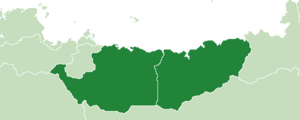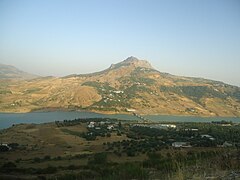Rubric Coast Consortium
This article is incomplete because it is pending further input from participants, or it is a work-in-progress by one author. Please comment on this article's talk page to share your input, comments and questions. Note: To contribute to this article, you may need to seek help from the author(s) of this page. |
Rubric Coast Partnership | |
|---|---|
 Location of Rubric Coast Partnership member states (dark green) in North Scipia (light green) | |
| Type | International organization |
| Member states | |
| Leaders | |
• Messidorian delegate | |
• Tyreseian delegate | |
| Formation | |
• Establishment of the Messidor Union | 1831 |
• Unification of the Workers' Federation | 1881 |
• Ratification of the Rubric Coast Treaty | 1890 |
| Area | |
• Total | 1,510,720 km2 (583,290 sq mi) |
• Water (%) | 3.52 |
| Population | |
• 2020 estimate | 85,589,850 |
• Density | 56.66/km2 (146.7/sq mi) |
| GDP (nominal) | 2020 estimate |
• Total | $2.42 trillion |
• Per capita | $28,216.32 |
| Currency | Messidorian marque Messidorian qarit Tyreseian piaster |
| Time zone | UTC±0 and UTC+1 |
The Rubric Coast Partnership is a treaty organization composed of the Messidor Union and the Workers' Federation of Tyreseia formed in December 1890. Taking its name from the Rubric Coast, a shallow bay that borders the Periclean Sea from the western end of Aɣmatia to the eastern border of Tyreseia, the Rubric Coast Partnership is a series of agreements ratified under the Rubric Coast Treaty.
The agreements under the Rubric Coast Treaty govern a variety of areas. These include free trade, freedom of movement, energy grid integration, defense arrangements, and alliances between labour unions. Proposed agreements include a common currency, the merging of labour unions, and the formation of a Rubric Coast legislature. These proposals, among others, were not adopted.
In the present day, the Rubric Coast Partnership primarily facilitates industrial development and the exchange of resources and experts between the two nations. Labour union alliances mean that industry standards for education and safety are similar between the two countries, and also facilitate temporary migration for work or full-term immigration. The Rubric Coast Partnership also includes military defense plans, as well as coordination in logistics and technological development.
History
In 1879, Azmelqart Sidduni, a military commander, executed a coup against the Tyreseian government with the support of the nation's trade guilds. After unifying the Workers' Federation in 1881 and protecting the first elections, military reforms to discourage another coup were swiftly passed, abetted in part by strong developing relations with the neighbouring Messidor Union. Both syndicalist states shared major political objectives and cultures, though the execution of their systems differed. The political isolation of the two states and the hostility of neighbouring and regional monarchist powers led to even further rapprochement. Despite this, both states had to reckon with each other's cultural, social, and political differences.
The Rubric Coast Treaty was first drafted bilaterally with the intent of defining relations between the two states. In some early drafts, the Treaty was closer to the constitution of a new nation composed of Aɣmatia, East Merovia, and Tyreseia. The legislative and radically integrative provisions of the treaty were dropped as Tyreseians generally wanted to preserve their own sovereignty. The Messidorians also wished to maintain their constitutional arrangements.
The Treaty was ultimately signed and ratified in 1890. In its final form it was made into a living document that could change with the evolving relations of its two member states. Defining the borders of the nations, trade and tariff laws, and the rights of each state's citizens with regard to the other were among the earliest concerns. To achieve the purpose of the Treaty as a live document, the Rubric Coast Partnership was created to manage and deliberate on the relations of the member states. The Partnership is a treaty organization composed of government officials from each state, though power is delegated to agents and diplomats in practice.
Structure
In theory, the head of state of each nation co-chairs the governance of the treaty organization. In practice, power is delegated to each state's embassy doyens who jointly form the Rubric Coast Partnership Committee. The Messidorian delegates are ultimately beholden to the President of the Union while Tyreseian delegates are beholden directly to the Supreme Workers' Council.
The partnership has no permanent headquarters. Documents are typically stored in embassies or state archives. Conferences are generally held in a variety of locations including government buildings but also hotels or convention centres.
Languages
All agreements and the establishing treaty of the Rubric Coast Partnership are written in four languages: Adrasic, Audonic Latin, and Tyrian. The former two of these are the national languages of the Messidor Union. The latter two are the most common, though unofficial, languages of the Workers' Federation. Conferences and the negotiation process, in general, make use of these four languages as well, with translation services if necessary.
Border and movement treaties
The border between Aɣmatia and Tyreseia had long been defined by the Qeshet River that divides the two nations in the north. South of the Adrasic Mountains and the river's source, the border in the Ninva Desert remained porous and uncertain. Even in the 19th century, Kel Tenere populations in both nations paid little regard to where previous border claims lay and many existing border claims were contradictory. Most maps of the era simply marked approximate, dotted lines south of the mountains to mark the general area of the borders, but these lines were neither respected nor enforced.
As the Tyreseian syndicalist state stabilized in the 1880s, both its new government and that of the Messidor Union made it a prerogative to officially define their borders. One of the first agreements ratified under the Rubric Coast Treaty was the Qeshet Meridian Agreement of 1890. This agreement marked the Qeshet River as the official border in the north, plotted a defined border through the Adrasic Mountains and then followed the titular meridian south through the desert, carving out an additional region at the southern edge used by a Kel Tenere group of Tyreseian origin.
Despite their prerogative to define the borders of their respective nations, the members of the Rubric Coast Partnership also sought to increase mobility for workers, tourists, and commercial transportation. In 1901, the Trans-Qeshet Mobility Agreement introduced visa-free travel between citizens of the two states. Border stations were maintained for tariff control, immigration services, and other exigent circumstances.
Economic treaties
The Free Exchange Agreement of 1920 established free trade between Tyreseia and the Messidor Union. While individual unions may retain the right to preferred exchange with domestic suppliers, government-imposed tariffs and general duties at border crossings were abolished upon the agreement's ratification under the Rubric Coast Treaty. The inclusion of a free trade agreement was initially contentious. Many unions were afraid that the value of their labour could be undercut by foreign competition. Ultimately, the understanding that unions in both nations would endeavour to maintain relative parity in terms of labour value while enabling greater efficiency and access to resources led to its acceptance and ratification.
The Rubric Coast Partnership has also included a bundle of agreements that have served to integrate the energy grids of Tyreseia and the Messidor Union. Tyreseian nuclear plants contribute energy to Messidorian cities, particularly in North and South Zwawa at a preferred rate. In turn, the Messidor Union provides a large quantity of petroleum products to Tyreseia for emergency stockpiling and consumer use.
Labour alliances
Alliances between Messidorian and Tyreseian labour unions existed in informal or non-legal forms since the late 19th century. However, in 1944, the Union Alliance Form Agreement was ratified under the Rubric Coast Partnership, creating a voluntary framework for labour unions in a given state to form an alliance with a union in an equivalent industry in the other state. Unions can adopt the form voluntarily, though its adoption requires ratification by the membership of each constituent union.
The major benefits of the framework are both budgetary and political. Labour alliances are able to transfer funds between unions to fund development, industrial expansion, and union infrastructure. Committees in the alliances can establish further parity in working conditions and remuneration for workers. Labour alliances can also legally act as cartels by coordinating the pricing and distribution of products. The major political benefits of labour alliances are budgetary, but pooled resources with regard to political advocacy is another soft power benefit.



